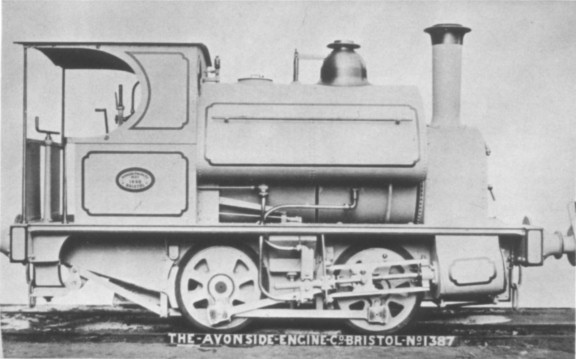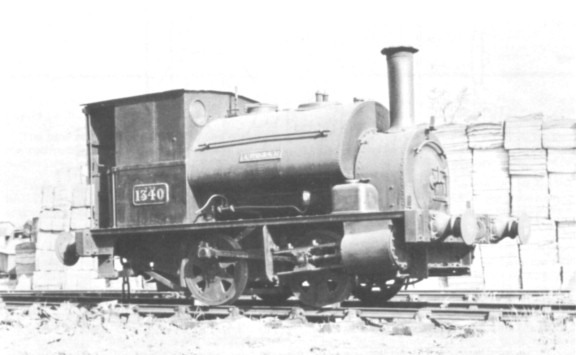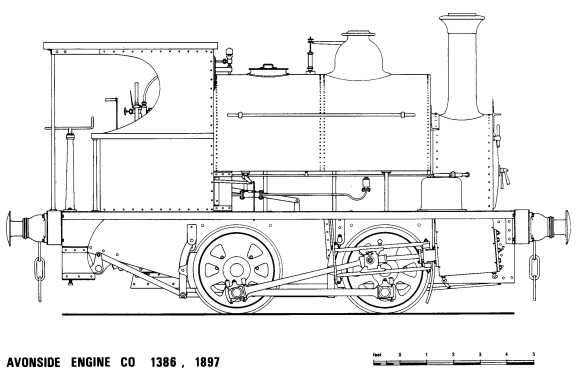
| THE INDUSTRIAL RAILWAY RECORD |
© JUNE 1973 |
TROJAN
F.W. HARMAN
During 1897 and 1898 the Avonside Engine Co Ltd constructed two 0-4-0 outside cylinder saddle tank locomotives to their order number 940, the works numbers being 1386 and 1387. After the reorganisation in the 1880's which resulted in the cessation of main line locomotive construction, the emphasis was directed to industrial types of which these two were typical examples. Basically 1386 and 1387 were Avonside class 'SS' locomotives, but not entirely; for whilst the boiler, wheels, bunker and cab were of standard 'SS' form, the cylinders were class 'B2' type and the frames and saddle tanks were 'specials'. Despite the fact that both locos shared the same order number there were a few minor differences, the most notable being a difference in boiler feed arrangement - 1387 was fitted with two Giffard No. 5 injectors with 1386 having one injector and one crosshead feed pump.
Avonside 1387 was purchased by J. & G. Joicey & Co Ltd for use at the Handen Hold Colliery in County Durham but is not well known, for it was broken up in the late 1930's. It was named WHITEHALL and carried a Joicey plate which gave the Joicey number as 457.

Official photograph of Avonside 1387, sister engine to TROJAN. (courtesy F. Jones)
The first of the two locomotives, however, is the well known TROJAN, which is now fortunately preserved. When new it was painted with two undercoats of lead followed by two top coats of green with yellow lining. It was purchased by Messrs. Dunn & Shute and sent to the Town Dock at Newport, which was shunted by these contractors at that time. The actual despatch date is unknown but the specification called for delivery on 17th July 1897. TROJAN stayed with its original owners until it was acquired in April 1903 by the Alexandra (Newport & South Wales) Docks & Railway Company when they took over the working of the docks from Dunn & Shute. TROJAN did not carry an ADR number but became 1340 when the ADR amalgamated with the GWR on 1st January 1922: it retained its name, which it still carries. In July 1932 TROJAN was withdrawn from service and placed on the sales list: by this time it had lost the characteristic Avonside steam dome cover. It had probably been reboilered by this time, for the steam dome was not as tall as the original. TROJAN was purchased from the GWR in June 1934 by the Victoria Colliery Company, a firm of colliery plant dealers of Princess Street, Wellington, Shropshire. It was hired to the Netherseal Colliery in Derbyshire and was still there when ownership of the colliery passed to the Moira Colliery Co Ltd in 1942: whether the new owners purchased TROJAN at this stage or continued to hire it is not known. In 1946 TROJAN was purchased by Alders (Tamworth) Ltd and it remained at Tamworth for the rest of its 'industrial' life, being eventually acquired for preservation by Mr J.B. True in March 1968. TROJAN now resides at the former GWR motive power depot at Didcot in the company of other former GWR locomotives.
The original dimensions of 1386 and 1387 were:-
| Cylinders | 14in x 20in | Heating surface: | ||||
| Motion | Inside Stephenson operating | Firebox | 52 sq ft | |||
| slide valves | Tubes | 414 sq ft | ||||
| Boiler barrel: | Total | 466 sq ft | ||||
| diameter | 3ft 5½in | Grate Area | 8¼ sq ft | |||
| length | 8ft 3¼in | Water Capacity | 630 galls | |||
| pitch | 5ft 3½in | Coal Capacity | 10 cwt | |||
| Working pressure | 140 psi | Weight (in working order) | 22 tons 17 cwt | |||
| Number of tubes | 113 | Length over buffer beam | 18ft 0in | |||
| Diameter of tubes | 1¾in | Width over buffer beam | 8ft 0in | |||
| Wheel diameter | 3ft 3in | Height (rail to chimney top) | 11ft 2½in | |||
| Wheelbase | 5ft 6in | |||||

Few changes have been made to the appearance of TROJAN during its existence. Most noticeable, apart from the removal of the dome, is the additional cab side sheeting which can be seen in this photograph taken at Alders (Tamworth) Ltd in 1956. (F. Jones)

'M. Schneider's workmen are subscribing for a monument to his memory at Creuzot. They decline to receive contributions from outsiders.' ("Iron," 8th January 1876. - KPP)
'The new shafts of the Cannock and Huntington Colliery Company (Limited) are about to be commenced immediately, as also the tramway which is to connect the colliery with the Penkridge basin of the Staffordshire and Worcestershire Canal.' ("Iron," 26th February 1876.
— KPP)'Tenders will be received from competent parties for the CONSTRUCTION of a NARROW GAUGE RAILWAY from Larne to Ballymena, in the county of Antrim, with BRANCH LINES ... All Tenders to be addressed to the Directors of the Ballymena and Larne Railway Company, 6, Chichester Street, Belfast.' ("Iron, -26th February 1876.
— KPP)'Malden Island is something like Christmas Island in its general features, being covered with white glaring sand overlying coral, and almost devoid of trees. The first objects which we sighted were the three masts of a vessel which was loading with guano; ... Messrs. Grice Summers and Co., of Melbourne, who are at present working guano here, have laid down three sets of moorings … The guano fields which are being worked at present are at the other end of the island, and a tramway, about five miles in length, has been constructed to bring the guano down to the pier. The hauling work on the tramway is done by sail power and by hand. There are neither horses nor steam locomotives. The trucks are pushed up to windward, loaded, and then sail is made, and the tram comes along at a fine rate. The engine truck carries a single mast in its centre, rigged with a large sail. The first time I saw the train the trucks were empty. I asked the man in charge to hoist his sail while I took a photograph. He accordingly did so, but the trucks having neither way on them nor ballast in them, the engine promptly capsized.'
(Extracts from the serialised article "Through the South Sea Islands in a Man-of-War" by "Guns", which appeared in the issue of "Engineering" dated 15th February 1889. Malden Island lies in the South Pacific, over a thousand miles north-east of Fiji. — BWL)